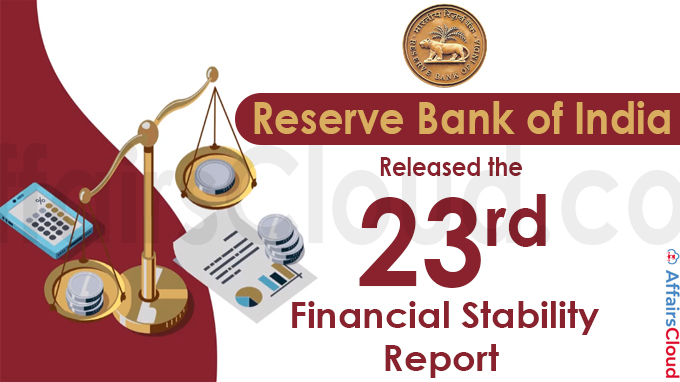 On July 01, 2021, Reserve Bank of India (RBI) released the 23rd issue of its bi-annual Financial Stability Report (FSR) 2021. It estimated the Scheduled Commercial Banks (SCBs) Gross Non-Performing Assets (GNPAs) to rise by 9.8 percent in March 2022 (as per the baseline scenario), from 7.48 percent in March 2021.
On July 01, 2021, Reserve Bank of India (RBI) released the 23rd issue of its bi-annual Financial Stability Report (FSR) 2021. It estimated the Scheduled Commercial Banks (SCBs) Gross Non-Performing Assets (GNPAs) to rise by 9.8 percent in March 2022 (as per the baseline scenario), from 7.48 percent in March 2021.
- As per the severe stress scenario, the GNPAs in March 2022 was estimated to be 11.22 percent. The report stated economic recovery in May and early June 2021.
What is FSR?
- It is the bi-annual collective assessment of the Sub-Committee of the ‘Financial Stability and Development Council’ (FSDC-SC) on risks to financial stability.
- The current report was based on RBI’s macro stress tests covering the Second Half-yearly(H2) (October – March) FY21.
Financial Stability Report Key Projections:
i.H2 FY21 Projection of SCBs’ GNPA and NNPA Ratio:
| Type | GNPA Ratio | Net Non-Performing Assets (NNPA) Ratio |
|---|---|---|
| All SCBs | 7.5% | 2.4% |
| Public Sector Banks (PSBs) | 9.5% | 3.1% |
| Private Banks (PVBs) | 4.8% | 1.5% |
| Foreign Banks (FBs) | 2.4% | 0.6% |
- GNPA ratio of NBFCs (Non-Banking Finance Companies) declined marginally to 6.4 percent in FY21.
ii.Capital to Risk-weighted Assets Ratio (CRAR):
- The CRAR of SCBs increased by 130 bps from 14.7 percent in March 2020 to 16.0 percent in March 2021
- CRAR of Scheduled urban co-operative banks (SUCBs) was also improved to 9.5 percent in March 2021
iii.CET-1: The Common Equity Tier I (CET-1) capital ratio of SCBs is estimated to decline from 12.78 percent in March 2021 to 12.58 percent in March 2022 (Under the baseline scenario).
iv.Provisioning Coverage Ratio (PCR):
- The overall provisioning coverage ratio (PCR) increased from 66.2 percent in March-2020 to 68.9 percent in March 2021.
- Note – PCR is the percentage of bad assets that the bank has to provide for from their own funds.
v.Bank Credit Growth:
- Bank credit increased by 5.4 percent (y-o-y), which was the lowest in the last 4 financial years.
- Credit extended by PSBs, PVBs and NBFCs increased by 3.2 percent, 9.9 percent, and 8.8 percent (y-o-y), respectively.
- The private corporate sectors’ share in total bank credit reduced from 37.6 percent to 27.7 percent during the 7-year period 2014-2021.
Other Points to be noted:
i.The gross fiscal deficit of the central government amounted to 9.3 percent of GDP in FY21 lower than the revised estimate (9.5 percent).
ii.Net Foreign Portfolio Investment (FPI) inflow during FY21 stood at US$ 36.2 billion as against a net outflow of US$ 3.0 billion in FY20.
iii.India’s merchandise exports and imports contracted by 7.3 percent and 18.0 percent, respectively, in FY21.
iv.The RBI’s average daily net liquidity absorption stood at Rs 4,96,154 crore in FY21.
v.Provider and Borrower:
- In FY21, AMC-MFs (Asset Management Companies/Mutual Funds) maintained their position as the largest net providers of funds to the financial system, while Insurance companies became the 2nd largest net providers.
- NBFCs were the largest net borrowers of funds from the financial system and HFCs (Housing Finance Companies) were the 2nd largest one.
Recent Related News:
As per the ‘State of Economy’ report by the RBI in June 2021, India ranked 2nd after Turkey in terms of the shares of ‘Surplus Transferred from Central Banks to Governments’(as per percent of GDP). RBI has transferred 0.44 percent of GDP to the Government in FY21, in FY20 it was at the 4th position with 0.29 percent.
RBI has announced 7.81% as the applicable average base rate to be charged for the loans that are borrowed from Non-Banking Financial Company – Micro Finance Institutions (NBFC-MFIs) for the first quarter of Financial Year 2022 (Q1FY22).
About Reserve Bank of India(RBI):
Establishment– 1st April 1935
Headquarters– Mumbai, Maharashtra
Governor– Shaktikanta Das
Deputy Governors – Mahesh Kumar Jain, Michael Debabrata Patra, M. Rajeshwar Rao, T. Rabi Sankar




